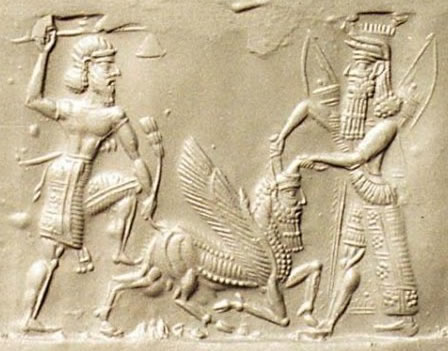
To confirm the validity of the Arabic-transliterated words and to translate a resulted text into a modern language, several historical Classical Arabic etymological references were then consulted. These impartial references listed various root words' meanings and usages, including discontinued usages, of Classical Arabic, a standard (high) Arabic language exclusively used by the educated few, inside and outside the Arabian peninsula, past and present. They were written between 800-1300 CE by prominent Muslim and Arab scholars, many centuries before the discovery of the epic. Although the resulting new translation seems to agree in its general lines with the current prevailing ones, so far, it seems to provide many new potentially important corrections and details. Regardless, this general agreement indicates strongly that the original language of the epic was indeed an early Classical Arabic language.
The Language of the Epic of Gilgamesh: Sumerian, Akkadian, or Early Arabic Language
It is difficult to claim with absolute certainty that the languages of the Akkadian and Sumerian people, which are only known through the reading of Cuneiform inscriptions, were actually two completely independent languages. Differentiating between the two is a complex process. To decipher the so-called Sumerian language, Western scholars initially turned to the so-called Akkadian. However, to translate the Akkadian, they turned to Hebrew, which is rooted in early Arabic, just like the Akkadian language. Based on the observations compiled so far in this work, the scattered words that were classified as Sumerian within the Akkadian text of the Standard Babylonian Edition (SBE) are of Arabic roots, too. Oddly enough, these Summerian words were accordingly used in the standard edition more than a thousand years after the Akkadian language had presumably replaced the Sumerian, while the Old Babylonian Edition (OBE), which dates back to around that conversion time period, was written in pure Akkadian!
Regrdless, one can not rule out that the so-called Sumerian language was just an earlier "writing script" and/or writing methodology of a much earlier ancient Arabic, predating the Akkadian. Discovering Sumerian Akkadian dictionaries on Cuneiform inscriptions is not a definite proof that the two languages were independent. It is possible that these dictionaries belonged to a single language, like thesauruses. Curiously, the early Muslim and Arab scholars pointed out that the language of old Babylon was the Nabataean (Arabic) language, and that the Chaldeans and Assyrians spoke two of its dialects. They referred to the Akkadians as the “Nabataeans of Iraq”, adding further that they were much older than the "Nabataeans of the Levant."
After pointing out to a prominent Assyriologist and a leading Western scholar of the Epic of Gilgamesh that the language of the epic of Gilgamesh seems be an early form of Classical Arabic and it should therefore be translated utilizing Arabic etymological references, he replied: “I am not convinced that your (Arabic) methodology is capable of producing a more accurate rendering than the (Western developed) Assyriological method”. (Words between parentheses added for clarification). Calling the translation process a "methodology" and not ruling out the Arabic language relevance, in this sincere and scientifically accurate reply, indicates two important points. First, if one is capable of producing a fairly accurate translation of the epic by utilizing the historical etymological references of the Classical Arabic language, then the language of the epic is early Classical Arabic. Naming it Akkadian by modern Western scholars or Nabataean by early Arab and Muslim scholars does not change that fact. Second, based on the above, the modern Akkadian and Sumerian dictionaries and grammar manuals should not be regarded as the exclusive, undisputed reference tools of actual, extinct, and non-Arabic languages, but as scientific methodology tools to decipher an earlier, written Arabic language.
Although this new Arabic-focused translation has not produced a significantly different story than “the Assyriological method” has, it has already produced “a more accurate rendering”, even in its early stages. It offers additional details and resolves several conflicting and questionable passages in the current translations. After all, as the saying goes, “the devil is in the detail”, and, as Mark Twain said, “The difference between the right word and the almost right word is the difference between lightning and a lightning bug”. Surely, it makes more sense to translate any text utilizing the tools of its actual language than newly created tools built around a speculative, statistical approach that is limited to a finite number of recovered inscriptions. At a minimum, employing the flexibility, depth, and consistency of the historical Arabic grammar and etymological references can significantly improve the outcome of a translation utilizing “the Assyriological method”.